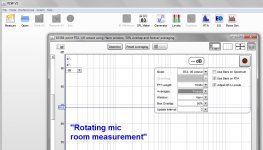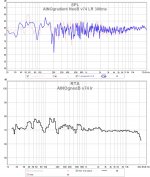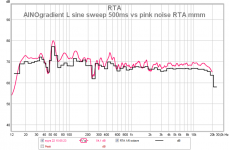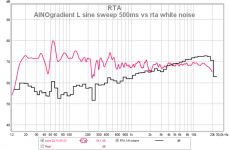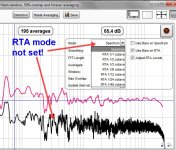MMM Moving Mic Measurement
Hi all,
to measure loudspeakers in a room, here is a presentation of my MMM method.
It is not a revolutionary method but it is quick and reliable.
http://www.ohl.to/audio/downloads/MMM-moving-mic-measurement.pdf
Hi all,
to measure loudspeakers in a room, here is a presentation of my MMM method.
It is not a revolutionary method but it is quick and reliable.
http://www.ohl.to/audio/downloads/MMM-moving-mic-measurement.pdf
Last edited:
Thank you jlo! I read and downloaded your pdf. 1-2kHz region is very sensitive to small movements of speaker or microphone (reflections!)
Room measurements should never be done at only one mic location. My friends have learned to me an easy way to do multiple measurement.
We use REW in RTA mode, Forever averaging. Play pink noise or pulsating pink noise with one or more speakers at the time, start RTA recording and move the mic slowly, 3-dimensionally around your head at your "sweet spot". The radius of movement should be 0.5m (2 feet). Continue recording for say 15 seconds. Then after stopping you can toggle for varius smoothing to see how the response looks.
The measurement reflects true room power response and audible spectral balance well. For learning measure several different speakers and compare measurements to your audition (how you hear them to sound).
Room measurements should never be done at only one mic location. My friends have learned to me an easy way to do multiple measurement.
We use REW in RTA mode, Forever averaging. Play pink noise or pulsating pink noise with one or more speakers at the time, start RTA recording and move the mic slowly, 3-dimensionally around your head at your "sweet spot". The radius of movement should be 0.5m (2 feet). Continue recording for say 15 seconds. Then after stopping you can toggle for varius smoothing to see how the response looks.
The measurement reflects true room power response and audible spectral balance well. For learning measure several different speakers and compare measurements to your audition (how you hear them to sound).
Attachments
Last edited:
I should try that too. Shouldn't pink noise have decreasing slope and white noise has "straight line"?
Yes by definition, but pink will measure flat! ½ or 1/3 oct smoothing is best. If L and R are playing simultaneously, highest treble will descend a little because of interferences.
Merci Jean-Luc! This is new to me. Certainly the averaged muti-position technique is well known, but the moving mic method is an interesting progression of that. Will have to give it a try. 

Juhazi - in ARTA using periodic pink noise, the measurement could be set to do 175 or even 200 averages. 60 secs is about 175, which should give good resolution down low.
I won't be able to test this until Tuesday, but will do so then and report my results.
I won't be able to test this until Tuesday, but will do so then and report my results.
Yes by definition, but pink will measure flat! ½ or 1/3 oct smoothing is best. If L and R are playing simultaneously, highest treble will descend a little because of interferences.
Here's 1ch, non-smoothed sweep vs. pink from listening sofa's back rest (non-moving mic). Pink noise (black curve) has noticeably more descending curve. White noise behaves like the sweep.

Last edited:
1/48oct smoothed sweep vs. moving mic white noise measured from listening spot:
An externally hosted image should be here but it was not working when we last tested it.
Strange! Here are my fresh measeurements - pink noise gives similar response to sine sweep! REW v5.1 beta22, digital out to ObjectiveDAC, measured with calibrated UMIK-1.
I wonder what is causing this difference to Legis' measurements?
Edit -I found it! Legis didn't have RTA mode set at RTA properties in REW
I wonder what is causing this difference to Legis' measurements?
Edit -I found it! Legis didn't have RTA mode set at RTA properties in REW
Attachments
Last edited:
Juhazi, try "Spectrum" view instead of 1/48oct RTA. I Just noticed this, but I don't know why they have such a difference?? Very strange, maybe a bug? Also the level in spectrum view drops drastically. I wondered why I had to play so loud...
Last edited:
When REW is in spectrum mode, it is measuring energy in linearly equal width frequency bins (~ 5Hz for 8192 samples @ 44.1 kS/s). So energy from 40 Hz to 45 Hz is summed and displayed on the same scale as energy from 12460 Hz to 12465 Hz and pink noise shows up with a -6 dB/octave slope and white noise is flat.
With 1/XX octave RTA, logarithmically equal frequency bins are used, so energy from 40 Hz to 80 Hz is summed and compared to energy from 4000 Hz to 8000 Hz, for example. Pink noise is flat, and white noise has a rising slope of 6 dB/octave.
Marc
With 1/XX octave RTA, logarithmically equal frequency bins are used, so energy from 40 Hz to 80 Hz is summed and compared to energy from 4000 Hz to 8000 Hz, for example. Pink noise is flat, and white noise has a rising slope of 6 dB/octave.
Marc
Last edited:
And here is John Murray explaining FFT and RTA measurements. RTA is 2D, it is sort of tolerant to decay/reflections/phase shifts, they are in the measurements and thus RTA represents auditioned sound in a reverberant space. This is also a limitation and we must use proper method for the task.
AV: What’s The Measurement? Understanding And Properly Using RTA & FFT - Pro Sound Web
AV: What’s The Measurement? Understanding And Properly Using RTA & FFT - Pro Sound Web
I'm doing an FFT of the whole measurement recording and then a 1/f compensation in the plot (-3dB/oct) so that pink looks flat.With 1/XX octave RTA, logarithmically equal frequency bins are used, so energy from 40 Hz to 80 Hz is summed and compared to energy from 4000 Hz to 8000 Hz, for example. Pink noise is flat, and white noise has a rising slope of 6 dB/octave.
Pink noise does not plot flat with an FFT analysis. White nose does, more or less.
That why your software needs to be in RTA mode when using pink. Pink works great for 1/3 octave Real Time Analyzers.
That why your software needs to be in RTA mode when using pink. Pink works great for 1/3 octave Real Time Analyzers.
and pink noise shows up with a -6 dB/octave slope and white noise is flat.
...
Marc
I'm doing an FFT of the whole measurement recording and then a 1/f compensation in the plot (-3dB/oct) so that pink looks flat.
Sorry. I was too quick to answer. I was thinking it was 1/f on amplitude, but it is 1/f in power, hence -3dB/octave, and equal energy in each octave.
Marc
That's exactly why I said above that you need the 3dB/oct compensation on the plot.Pink noise does not plot flat with an FFT analysis.
Wow, this is definitely not working for me in ARTA. 
With a stationary mic I get the same results in ARTA and HOLM. Can move the mic position 10cm laterally and there is very little change. (1/6th octave).
But with the moving mic there is a giant roll-off above 300Hz. The response slopes diagonally down hitting -30dB at 20KHz. No way it sounds right if that is EQ'd to flat.
Doesn't seem to matter how far or in what pattern the mic moves, the roll-off is the same. Bass changes very little.
Maybe it has to do with the periodic pink noise in ARTA? Gotta keep testing.

With a stationary mic I get the same results in ARTA and HOLM. Can move the mic position 10cm laterally and there is very little change. (1/6th octave).
But with the moving mic there is a giant roll-off above 300Hz. The response slopes diagonally down hitting -30dB at 20KHz. No way it sounds right if that is EQ'd to flat.
Doesn't seem to matter how far or in what pattern the mic moves, the roll-off is the same. Bass changes very little.
Maybe it has to do with the periodic pink noise in ARTA? Gotta keep testing.
I can do it with ARTA right at my desk here, and nothing seems out of the ordinary. Let me know if you want me to try some specific settings or something.
Pano, I've also experienced extreme roll-off in the past averaging periodic noise in ARTA. Never could figure it out.
- Home
- Loudspeakers
- Multi-Way
- Moving Mic Measurement
